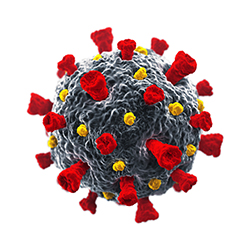The COVID-19 Tipping Point

There are a few points in history, most of them incredibly tragic, that forever change the world. The world before 9/11 was drastically different than after 9/11. The world after World War II was dramatically different than the years that preceded it. And it was more than the world-changing event itself. The shockwaves that radiated from these events changed the way we work, live, and even think to this day.
Prior to 9/11, for example, I remember arriving at the airport 45 minutes before a flight, briskly walking directly to the gate, and board the plane just as the doors were closing. No security, no TSA—just a guy with a ticket getting on a plane. It felt free. Being able to precisely time it left me with a sense of great accomplishment. I even recall friends and family meeting me at the arrival gate after landing—regardless of whether or not they had a ticket—with no pat downs or invasive x-rays of their person. No disrobing of shoes and belts. Nobody peering through the clothing they wore.
Before World War II, children actually played outside. They headed home at dusk and into the arms of their loving mothers. Nuclear weapons had never been used. The threat of nuclear war did not
exist. Israel was still Palestine. But all that changed. “Duck and cover” became a schoolhouse mantra. NATO was formed. Foreign policy forever changed around the world. Terrorism was born.
Millions of women, children, and minorities joined the workforce to support the war effort; giving rise to the middle class, dual-income households, and an expanded credit market. Prior to World
War II you could buy a home for a few thousand dollars and a car for a few hundred. Now you can finance a fifty-thousand-dollar Durango for six years, and a home will cost you several hundred
thousand dollars, which you might pay off over the course of your lifetime. In fact, I'd argue much of the terror-ridden, credit-laden, and dual-income society in which we live today can be
traced back to the impact of World War II, including 9/11.
Then COVID-19 happened. The novel coronavirus, which causes the disease COVID-19 (COVID), has infected more than 4,000,000 people worldwide and nearly 300,000 people have tragically died from it to date. To put that into perspective, that’s ten times more people than died on 9/11. About three percent of the world’s population at the time died in World War II, and COVID has a 7.5 percent mortality rate worldwide. A rate which may climb as non-diagnosed, and post-viral syndrome deaths are added to its rate of morbidity. And, while the rate of infection is slowing in some areas, it is holding firm and even increasing in others. Households, places of work and worship, cities, states, and entire countries have been locked down, with—in some cases—police-enforced stay-at-home orders in place, and these are being extended by months in others.
Prior to COVID, children went to school. Parents went to work. Friends and family came to visit. Packages that arrived were eagerly opened, and not left on the porch for hours (the obligatory waiting period to allow the virus to die on cardboard surfaces). People went to stores, malls, and occasionally ordered take-out from their favorite restaurants. They went out to sporting events and concerts. In fact, there were live sporting events people could actually attend. Ttoday, the treatment for COVID is obscure, and mass vaccines are one to two years away at best. But we didn’t go into this global pandemic totally unprepared.
As I wrote in my Letter from the Editor in the last issue of Pipeline, we are now leveraging technology that has existed for years, decades, or more. Voice-over-IP applications and online shopping sites, like Skype and Amazon, have been around a long time. Social media applications, such as Twitter and Facebook; enterprise networking applications, such as Slack and Yammer; digital document formats, such as Adobe PDF and DocuSign; and digital payment platforms, such as PayPal, have been around for about as long. Video conferencing applications, like Zoom, Citrix GotoMeeting, and Cisco Webex, have been available for years, as has telemedicine and virtual PBX platforms, such as Teledoc and RingCentral. Their predecessors—even longer. Anyone remember SunRocket (VoIP), AOL or Yahoo! Instant Messenger, Dialpad.com (virtual phone service), PaymyBills.com (automated digital payment platform), or MySpace (social media)? Anybody still use eBay? I do. These programs,


















